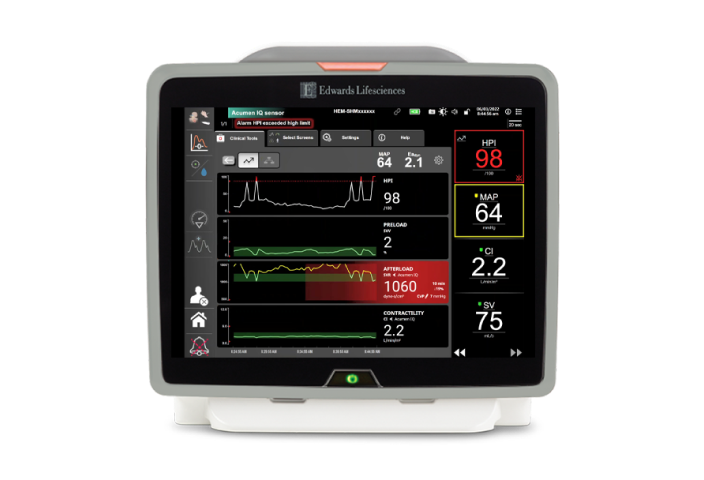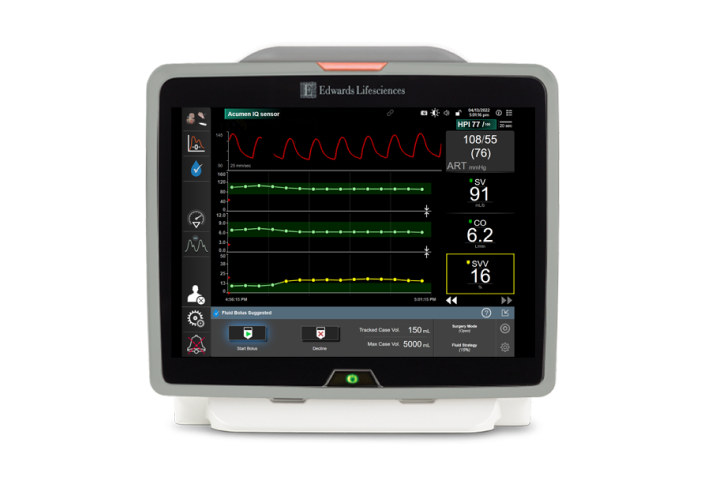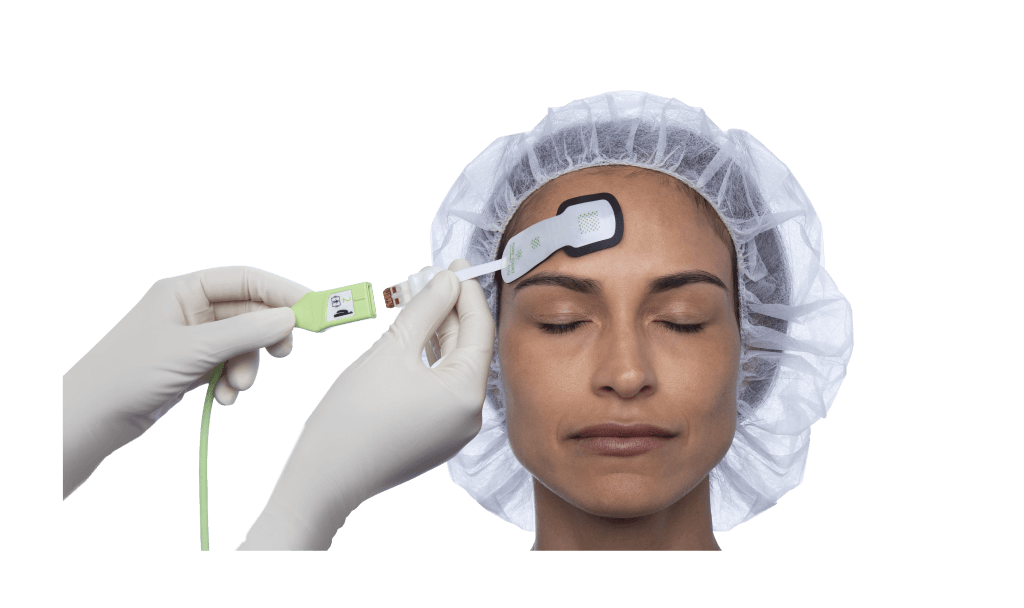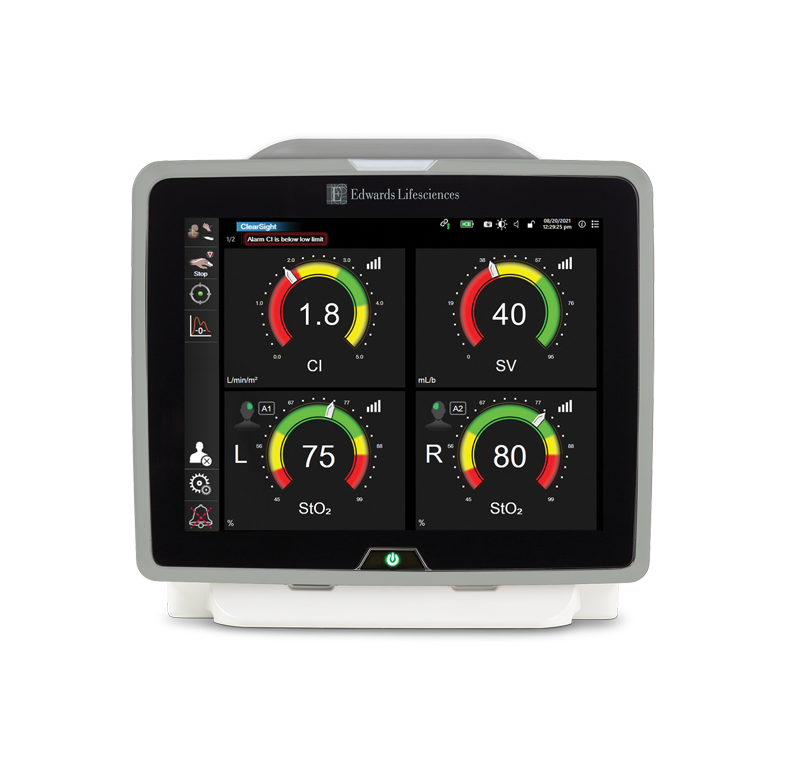Anesthesia Teams

Stay ahead of critical moments
Today you are faced with an increasingly complex patient population. HemoSphere advanced monitoring platform provides a comprehensive view of tissue oximetry and hemodynamics, giving you confidence in knowing continuous oxygen saturation and perfusion.
For more than 50 years, Edwards Lifesciences has been helping you make proactive clinical decisions and advance the care of surgical and acutely ill patients across the continuum of care.
Hypotension management
Intraoperative hypotension (IOH) matters. Studies show significant associations of IOH with increased risk of acute kidney injury (AKI), myocardial injury, and mortality.1-3 Prolonged exposures below mean arterial pressure (MAP) thresholds of 65 mmHg are associated with an increased risk of myocardial injury and AKI after noncardiac surgery.1
Related products


Acumen Hypotension Prediction Index (HPI) software
Acumen HPI software is effective in detecting hemodynamic instability and substantially reducing the duration of intraoperative hypotension.*4
*Compared to a retrospective historical control group, in noncardiac surgical patients requiring arterial line monitoring.
Perfusion management
Advanced hemodynamic monitoring provides access to continuous pressure and flow parameters, giving you valuable insight into the adequacy of perfusion. Dynamic parameters can help identify the most appropriate therapy, such as helping to decide between volume administration or the administration of vasopressors or inotropes.
Related products


Acumen Assisted Fluid Management (AFM) software
Acumen AFM software* is a first-of-its-kind machine learning solution that provides decision support to enable you to deliver adaptable, individualized fluid management and optimize fluid administration.
*Indicated for surgical patients ≥ 18 years of age.
Mitigate cerebral desaturations
Research has consistently shown that cerebral desaturations are common across a broad spectrum of surgical procedures and patient populations – and that they can cause significant complications when left untreated, including increased hospital & ICU length of stay.5-12 By understanding the incidence, risks and interventions available to address them, you may be able to identify and even reverse cerebral desaturations.
Related products

ForeSight tissue oximetry sensor
ForeSight system delivers absolute StO2 values that – when used in combination with the full hemodynamic insights delivered by HemoSphere advanced monitoring platform – enable you to confidently recognize and address cerebral desaturations.
Edwards clinical education
With a long-term commitment to improving the quality of care for surgical and critical care patients through education, Edwards clinical education meets you no matter where you are in the learning process—with a continuum of resources and tools that continuously support you as you solve the clinical challenges facing you today, and in the future.

References
- Salmasi V, et al. Relationship between Intraoperative Hypotension, Defined by Either Reduction from Baseline or Absolute Thresholds, and Acute Kidney and Myocardial Injury after Noncardiac Surgery: A Retrospective Cohort Analysis. Anesthesiology. 2017 Jan;126(1):47-65.
- Mascha EJ, et al. Intraoperative Mean Arterial Pressure Variability and 30-day Mortality in Patients Having Noncardiac Surgery. Anesthesiology. 2015 Jul;123(1):79-91.
- Wijnberge M, et al. Association of intraoperative hypotension with postoperative morbidity and mortality: systematic review and meta-analysis. BJS Open. 2021 Jan 8;5(1):zraa018.
- U.S. Food and Drug Administration. 2021. K203224 510k Summary, Acumen Hypotension Prediction Index
- Yao FSF, et al. Cerebral oxygen desaturation is associated with early postoperative neuropsychological dysfunction in patients undergoing cardiac surgery. J Cardiothorac Vasc Anesth. 2004;18(5):552-558.
- Murkin JM, et al. Monitoring brain oxygen saturation during coronary bypass surgery: a randomized, prospective study. Anesth Analg. 2007;104(1):51-58.
- Schön J, et al. Cerebral oxygen saturation monitoring in on-pump cardiac surgery – A 1 year experience. Appl Cardiopulm Pathophysiol. 2009;13: 243-252.
- de Tournay-Jetté, et al. The relationship between cerebral oxygen saturation changes and postoperative cognitive dysfunction in elderly patients after coronary artery bypass graft surgery. Cardiothorac Vasc Anesth. 2011;25(1):95-104.
- Deschamps A, et al. Reversal of decreases in cerebral saturation in high-risk cardiac surgery. J Cardiothorac Vasc Anesth. 2013;27(6):1260-1266.
- Greenberg SB, et al. Cerebral desaturation events in the intensive care unit following cardiac surgery. J Crit Care. 2013;28(3):270-276.
- Deschamps A, et al. Cerebral oximetry monitoring to maintain normal cerebral oxygen saturation during high-risk cardiac surgery: a randomized controlled feasibility trial. Anesthesiology. 2016;124(4):826-836.
- Subramanian B, et al. A multicenter pilot study assessing regional cerebral oxygen desaturation frequency during cardiopulmonary bypass and responsiveness to an intervention algorithm. Anesth Analg. 2016;122(6):1786-1793.
Important safety information
CAUTION: Federal (United States) law restricts this device to sale by or on the order of a physician.
See Instructions For Use (IFU) / Directions For Use (DFU) for full prescribing information, including indications, contraindications, warnings, precautions and adverse events.

